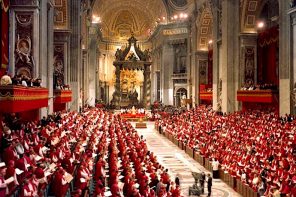Today’s Washington Post profile of Rick Santorum’s transition from hippie-priest-admiring-Catholic to admirer, if not member of, Opus Dei, is like sticking one’s toe in to test the temperature of the water, and, finding it tepid, deciding not to jump in.
For a deep dive into the Washington scene, Charles Pierce’s 2003 piece about Opus Dei in the Boston Globe magazine adds important context not only to Santorum’s flourishing into a rigid Catholic ideologue, but to the Beltway political culture in which such conservative politicians were groomed. The piece also helps explain, rather presciently, how a conservative Catholic like Santorum could be winning over evangelicals, but not his fellow Catholics.
Most notable about today’s Washington Post piece was the description of Santorum’s 1970s boyhood experience with Catholicism, when churches were adapting to Vatican II policies. In the church where Santorum was confirmed, “young priests, some wearing jeans and longer hair, talked about morally complex situations” — precisely the zeitgeist that Santorum now rejects.
Fast-forward to his political career, and his decision in the late 1990s to “assert his faith more publicly,” working with the Rev. C. John McCloskey, an Opus Dei priest and prominent figure in Washington conservative Catholic circles. It was during this period, in 2002, that Santorum traveled to Rome with McCloskey for the canonization of Jose Maria Escriva de Balaguer, the Spanish priest who founded Opus Dei in 1928 (in canonizing Escriva, Pope John Paul II called him “the saint of ordinary life.”) While in Rome, Santorum first publicly rejected John F. Kennedy’s view of church-state separation and rejected the church of his childhood, claiming that the priest sex abuse scandal was caused by cultural factors external to the church. “When the culture is sick, every element in it becomes infected,” Santorum said. He disparaged “watered-down versions of our faith.”
Pierce examines the pivotal role of McCloskey, who from 1998-2002 directed the Catholic Information Center, which appears from the outside to be an unremarkable bookstore on K Street, just blocks from the White House. The CIC, of late, has been hosting speakers who claim the HHS contraception coverage requirement infringes on religious freedom and that contraception itself is inimical to true womanhood.
There’s a name for Catholics who dissent from church teachings, McCloskey told Pierce: “Protestants.” And while the Catholics who follow the traditionaiist view of McCloskey are few, they are among the powerful, and that appears to be by design. From the piece:
Since returning to Washington to run the Catholic Information Center for Opus Dei, McCloskey has taken his mission onto Meet the Press and to CNN. He’s preached it in USA Today and inThe New York Times. More famously, he has brought into Catholicism several members of the conservative elite. McCloskey personally baptized Judge Robert Bork, political pundits Robert Novak and Lawrence Kudlow, publisher Alfred Regnery, financier Lewis Lehrman, and US Senator Sam Brownback of Kansas, whose baptismal sponsor was another senator, Rick Santorum of Pennsylvania. In 2000, McCloskey baptized Mark Belnick, the embattled top lawyer at Tyco International, who responded by donating $2 million to a Catholic college and to an antiabortion group.
McCloskey makes no apologies for his role as the apostle to the punditocracy. (One of the volunteers at the Catholic Information Center is Linda Poindexter, a former Episcopal priest and the wife of Iran-contra figure and Bush administration official John Poindexter.) He has written that the Gospel was most successfully preached not to the poor but rather to the educated middle and upper classes.
“I don’t talk politics with them,” he says. “It just so happens that they’re Catholics, and I have to be informed about key issues in order to talk to them, because they’re not just issues to these people — they’re a matter of natural law; they’re a matter of divine revelation and things of that sort. I don’t tell them how to vote on this issue or that issue. Ever. But if it seemed to me to be a moral question as to what the material cooperation with evil is on this bill or the other, I might be able to give them some guidance.”
Pierce borrows the reformation metaphor to explain the McCloskey circle as a sort of counterreformation within Washington:
In his unobtrusive little bookstore in the nation’s capital, John McCloskey is the hot, unyielding eye of a gathering storm. He is not the mainstream, not even among the conservative Catholics who are waging their secular influence in a way they never have before, but he’s the logical end to what they all believe. During the almost two years since the clergy sexual abuse scandal broke in Boston, most of the attention has been drawn to groups like Boston-based Voice of the Faithful that sprang up in response to the grim stories that seemed to be breaking almost daily. Outraged laity took to the streets and rose up in the pews, withholding contributions, demanding meetings with bishops whose authority seemed to be evaporating by the hour.
Obscured by all of this was the presence of an influential, deeply connected, and well-financed faction — a counterreformation, to borrow a useful term from Roman Catholic history — that was determined not only to prevent the scandal from being used as a Trojan horse for all manner of church reform but also to use its efforts within the church to affect the politics and culture outside of it.
The conservative opposition is tied in to the elites of Washington, D.C. — McCloskey’s high-profile catechumens are hardly the only example — and its magazines and think tanks are funded by the same foundations that have been the fountainhead of movement conservatism over the past three decades. And just as the clergy sexual abuse scandal energized the reformers, it energized the traditionalists.
“That’s where the leadership and the power of the church are right now, no question,” says the Rev. Richard McBrien, a theologian at the University of Notre Dame. “These people have direct access to the papacy.”
The group Opus Dei Awareness Network, founded by former members and family of Opus Dei members, lists the organization’s “questionable practices” of “corporal mortification,” “aggressive recruitment / undue pressure to join,” “lack of informed consent and control of environment,” and “alienation from families.” ODAN’s website describes Opus Dei’s aggressive recruitment tactics and lists Opus Dei’s “index of forbidden books,” based on a list maintained by the Vatican until 1948, and which has been updated to tellingly include those by writers such as Margaret Atwood, author of The Handmaid’s Tale. (Opus Dei denies that there is an official list of forbidden books, but rather that it maintains a database for members to consult, as it identifies “books that without even dealing with religious themes are impregnated with an anti-Christian ideology” or “reflect a deep consistency with the teachings of the gospel, others are immoral, others could be of great help for all types of readers, and so on.”) Fr. James Martin’s 1995 piece in the Jesuit magazine America also details Opus Dei’s questionable practices, offering the perspectives of both supporters and critics.
It’s really worth going back and reading the entire Pierce article; he discusses the role of people like Princeton’s Robert George, who has since played a crucial part in bringing Catholics and evangelicals together in the “religious freedom” cause through the 2009 Manhattan Declaration, which is very much a roadmap for the opposition to the HHS contraception benefit requirement. (“Among other things,” Pierce wrote, “George regularly compares the abortion pill RU-486 to the Zyklon B gas used by the Nazis in concentration camps during World War II,” an apparent prelude to today’s discourse.) Pierce notes that Deal Hudson, who helped the George W. Bush presidential campaign with outreach to Catholics, wrote a “prescient” 1995 piece in his magazine Crisis, “about a possible alliance between evangelical Protestants and conservative Catholics.” Deal wasn’t the first, of course; Francis Schaeffer famously called for co-belligerence as well, and the religious right political architecture was built in the 1970s both by Catholics like Richard Viguerie and evangelicals like Tim LaHaye. (Deal was later disgraced in a sexual harassment scandal, but he’s still around with this group the Catholic Advocate, and has called for a “Catholic tea party.“)
Today, the evangelical-Catholic alliance is hardening around the “religious freedom” issue, and in particular opposition to gay marriage and, most recently, the contraception benefit requirement. Santorum is almost like an accidental beneficiary of this; the GOP base, lacking an evangelical candidate left standing, and dissatisfied with Mitt Romney, has turned to his fidelity to ultra-conservative Catholicism as evidence of his trustworthiness, his authenticity. Exit polls in primary states with significant evangelical and Catholic populations have shown greater support for Santorum among evangelicals than Catholics.
Opus Dei critics like to say the organization is “more Roman than Rome.” It’s one of the stranger phenomena of our current political culture that Republican evangelicals are more drawn to that purist ideology than Republican Catholics are.




